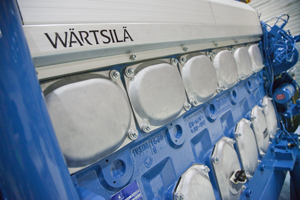Major Cocaine Bust: UK Border Force Seizes Record Shipment at London Gateway
In one of the UK’s largest drug seizures of the past decade, UK Border Force officers have seized cocaine with an estimated street value of £96 million (USD 130 million)...

Wärtsilä announced today that they have been contracted by Koedood Diesel Service BV to supply a complete power system, including two of its 6-cylinder Wärtsilä 20DF dual-fuel medium-speed engines, for a new, 135 meter dry cargo inland waterway vessel. This order extends the benefits of gas fueled operation to an inland waterway vessel, and represents a strong endorsement of gas as a marine fuel. The vessel will be part of the ECO2 Inland Vessel project, which is focused on developing innovative measures for making the inland shipping sector more economically and environmentally sound. A transition to liquefied natural gas (LNG) is widely viewed as being one of the most realistic options for significantly reducing the environmental footprint of marine transportation.

This will be the first-ever medium speed, dual-fuel, mechanically driven inland waterway vessel capable of operating for 95-99 percent of the time on LNG fuel, with a minimum of pilot marine gas oil (MGO) used for ignition. The engines are also capable of operating fully on MGO. In addition to the two Wärtsilä dual-fuel engines, the scope of the order includes two fixed pitch propellers in a nozzle, the coldbox, and the LNG tanks.
The above statement may appear a bit inaccurate as Lloyd’s Register announced at the end of 2011 the delivery of the dual-fuel powered chemical tanker MT Argonon which will operate via 1,115 KW Caterpillar DF3512 engines on inland waterways, however that vessel will operate on an 80/20 mixture of gas to diesel and the CAT engines are rated as “high speed”. Wärtsilä engines, using a slightly different technology, operate at a higher ratio of gas to diesel.
That is the primary distinction between the two vessels.
This new vessel, being built for Dutch shipowner Combi International, will set new standards in environmentally and economically sustainable operations on inland waterways in the Netherlands, Germany, Switzerland, Belgium and France.
ECO2 Inland Vessel project
The vessel is the first of three inland vessels that will serve as pilots for innovative, environmentally sound power systems (engines and propulsion) for inland shipping. All three vessels will be designed, tested and implemented within the ECO2 Inland Vessel project.
A consortium of companies have joined forces in this project with Wärtsilä Netherlands BV as the co-ordinating partner. The other partners are Koedood Diesel service, Combi Group BV, Reederei Deymann, TNO, DST and Hochschule Emden-Leer.
The project’s goal is to identify the most efficient and economical power systems for various types of inland shipping vessels, to the ultimate benefit of the global inland shipping industry. The project is part of a larger initiative known as MariTIM (Maritime Technologies and Innovations Model region Germany-The Netherlands), sponsored by the EU.
“This ECO2 Inland Vessel project is helping the inland shipping industry to become more sustainable, whilst at the same time increasing fuel efficiency and reducing costs. Under the auspices of the project, all three pilot vessels will be monitored for up to three years in order to provide valuable input data for future generations of inland waterway vessels. The Wärtsilä dual-fuel engines have proven their reliability throughout five million running hours, which clearly indicates our leading position in this field. Wärtsilä’s dual-fuel engine technology, which is well established in ocean going applications, can now be applied to small scale LNG fuelled vessel applications,” says Bram Kruyt, Director, Inland Water Ways, Wärtsilä Services at Wärtsilä Netherlands B.V.
Wärtsilä 20DF engines
Wärtsilä’s dual-fuel (DF) engine technology allows flexibility in fuel choice, since the engines can operate either on LNG, MGO or HFO. In gas mode, harmful exhaust emissions are drastically reduced since nitrogen oxide (NOx) emissions are cut by at least 85 percent, CO2 emissions by some 25 percent, while sulphur oxide (SOx) and particle emissions are reduced by almost 100 percent from those produced by standard diesel fuel marine engines. The engine is fully compliant with the IMO Tier III exhaust emission regulations.
Click here for more information about Wärtsilä 20DF engine

Sign up for gCaptain’s newsletter and never miss an update

Subscribe to gCaptain Daily and stay informed with the latest global maritime and offshore news


Stay informed with the latest maritime and offshore news, delivered daily straight to your inbox
Essential news coupled with the finest maritime content sourced from across the globe.
Sign Up